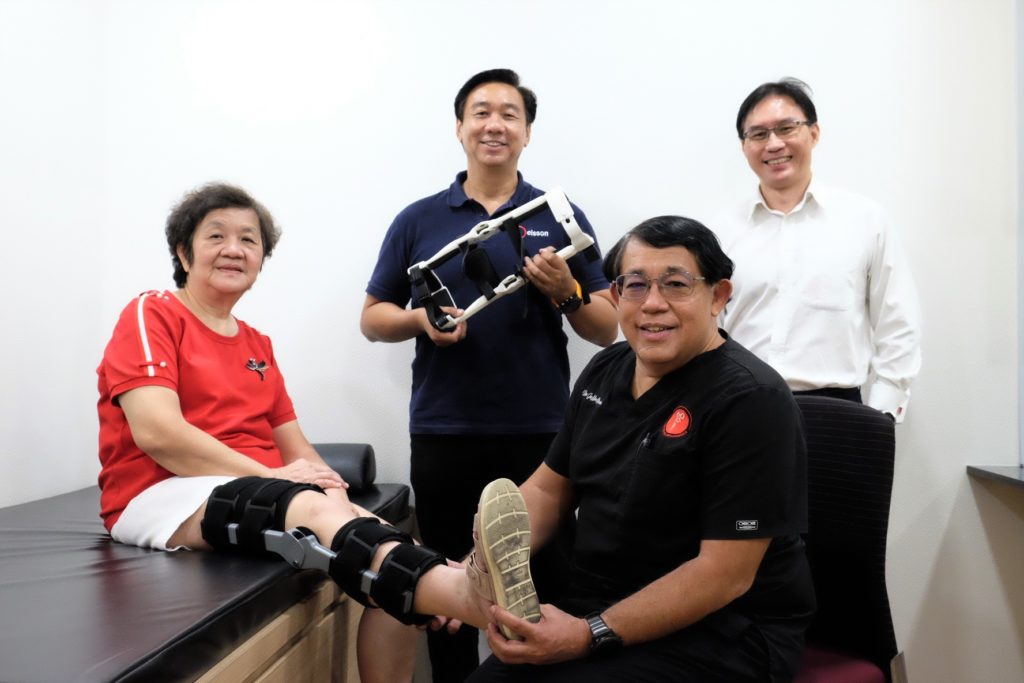Nanyang Technological University (NTU) researchers—along with Singapore’s National Additive Manufacturing Innovation Cluster (NAMIC), material supplier Delsson and the sports medicine-focused Centre for Orthopaedics—have developed a lightweight, 3D printed knee brace. The brace weighs 720 grams, 30% lighter than traditionally made counterparts, and could help relieve the suffering of many elderly individuals afflicted with knee osteoarthritis. Moreover, the brace’s resistance for the wearer can be customised from between 6 and 32 Kilos.
The team behind the X-Brace say that the device is reminiscent of one Batman uses in the Dark Night Rises. In addition to being 3D printed and lighter overall, the key advantage of the X-Brace is that the resistance can be customized to the patient. In this way, the knee can be set to stop extension of the knee beyond a certain angle. The spring tension can be adjusted to accommodate someone’s recovery, as well ,with doctors or physiotherapists changing spring tension at will according to the patent’s needs. In addition to individuals suffering from osteoarthritis, it could also aid those who have undergone knee surgeries or have issues with torn ligaments.

The brace was designed by Joel Lim, an NTU PhD Student working with NTU Assistant Professor Chan Wai Lee. Above, Professor Chan Was Lee is seated with the prototype, Joel Lim is standing and holding another prototype, as Centre for Orthopaedics Chairman Dr Jeffery Chew looks on and Delsson Executive Director Fabian Ong holds the final production knee brace.
Joel Lim explained that, “Lightweight and strength are crucial to this project. We first analysed the conventional knee braces and their current bill of material. We decided to change to a plastic material with optimised structure. Using topology optimisation with a delineated stress map and 3D modelling, we then designed new structures and joints that are strong enough to withstand the flex of the knee and still assist it to move in the correct direction,”
Fabian Ong said that, “X-Brace will be revolutionary for patient recovery. It is light weight and does not slip, while its modular assistance load allows patient recovery to be individualised. NTU’s help in providing a quantitative methodology to reduce wall thickness and profile of the frame was crucial in achieving the weight reduction after several reiterations,”

Lim has made seven iterations of the X-Brace to get to the commercially available variant and now uses nylon 6 (Stanyl) as a material, while the knee can support up to 50 kg of force. Meanwhile, Lim has not stopped development but is rather advancing further still with a ninth version. Currently available for sale for SGD$1,000 (US$782), it can be purchased from Delsson subsidiary Wearable Kinetics.
Dr Ho Chaw Sing, Managing Director of NAMIC said, “With a fast-aging global population, light-weight assistive orthotics enabled by 3D printing – such as personalized knee braces, will increasingly become an essential tool in geriatrics, to achieve better elderly patient care and outcomes.”

The market for devices like the X Brace is incredibly huge. As it stands, assistive devices and braces are boring, with an aesthetic straight from the 50s. The market is stratified, slow, and set in its ways. Through lightweight, customized and innovative solutions like this, we could, as a 3D printing industry, conquer many markets, make many billions of dollars in revenue, and help millions of people worldwide improve the quality of their lives. And we can do this with a part that is relatively easy to make and well within our means.
By all means have fun negotiating with Volkswagen for the next decade of your life or try to figure out how to replicate a legacy component and beat it on cost. Those are all valuable activities. But, in the world of assistive devices, you can quickly bring to market products that are high value, as well as innovative. To me this is a lot faster, more fun, and will be more profitable as well. Best thing I’ve seen all month.
Subscribe to Our Email Newsletter
Stay up-to-date on all the latest news from the 3D printing industry and receive information and offers from third party vendors.
You May Also Like
3D Printing Unpeeled: New Arkema Material for HP, Saddle and Macro MEMS
A new Arkema material for MJF is said to reduce costs per part by up to 25% and have an 85% reusability ratio. HP 3D HR PA 12 S has been...
3D Printing News Briefs, January 20, 2024: FDM, LPBF, Underwater 3D Printer, Racing, & More
We’re starting off with a process certification in today’s 3D Printing News Briefs, and then moving on to research about solute trapping, laser powder bed fusion, and then moving on...
3D Printing Webinar and Event Roundup: December 3, 2023
We’ve got plenty of events and webinars coming up for you this week! Quickparts is having a Manufacturing Roadshow, America Makes is holding a Member Town Hall, Stratafest makes two...
Formnext 2023 Day Three: Slam Dunk
I’m high—high on trade show. I’ve met numerous new faces and reconnected with old friends, creating an absolutely wonderful atmosphere. The excitement is palpable over several emerging developments. The high...































